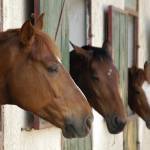Stable Vices and Cognitive Function in Horses

Horses have minds of their own, frequently expressing strong opinions and, in some cases, developing undesirable habits, like weaving or cribbing. According to a recent study*, these behaviors, commonly referred to as vices or sterotypies, result from cognitive abnormalities that, with more research, could finally be treatable.
Currently, methods of managing stereotypic behaviors predominantly rely on aversive measures or feeding and housing management changes such as:
- Using cribbing straps or anti-weaving bars;
- Removing or modifying surfaces on which cribbing may occur;
- Hanging obstacles at the front of the stable to prevent weaving;
- Tying or obstructing the path of stall walkers;
- Feeding a high-fiber diet and more frequent meals;
- Turning out horses instead of maintaining them in stalls;
- Ensuring horses have eye contact with others; and,
- Providing enrichment objects such as puzzles, balls, and mirrors.
Some of these techniques reportedly minimize the occurrence of stereotypic behaviors; however, the welfare implications surrounding some treatment options remains questionable. As such, having a better understanding of why horses develop stereotypies will facilitate the development of appropriate and effective therapies.
Researchers now know that some stereotypies, such as cribbing, result from a “hyperdopamanergic state” in which excess dopamine levels exist. Dopamine, a potent neurotransmitter, helps control the brain’s reward and pleasure centers, regulates emotional responses, and allows individuals to identify and seek out rewards.
Studies designed to map which pathways in the brain are impacted by dopamine not only helps horses with stereotypies, but also human patients with similar conditions, including Tourette’s syndrome and obsessive or impulsive disorders.
“Supporting brain development in young animals and minimizing cognitive dysfunction as a horse ages can be facilitated by supplementing diets with omega -3 fatty acids. Such supplementation can start with pregnant and nursing broodmares and continue for the duration of the horse’s life,” shared Kathleen Crandell, Ph.D., an equine nutritionist for Kentucky Equine Research (KER).
She added, “The omega-3 fatty acids found in EO•3 not only support brain development but also respiratory, reproductive, and joint health, to name only a few of the product’s benefits.”
*Roberts, K, A.J. Hemmings, S.D. McBride, et al. Developing a 3-choice serial reaction time task for examining neural and cognitive function in an equine model. Journal of Neuroscience Methods. In press.








